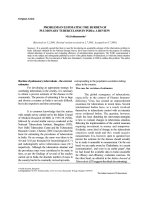3000 solved problems in physics
Bạn đang xem bản rút gọn của tài liệu. Xem và tải ngay bản đầy đủ của tài liệu tại đây (32.92 MB, 782 trang )
by
Alvin Halpern, Ph.D.
Brooklyn College
SCHAUM'S OUTLINE SERIES
McGraw-Hili
New York San Francisco Washington, D.C. Auckland Bogota
Caracas Lisbon London Madrid Mexico City Milan
Montreal New Delhi San Juan Singapore
Sydney Tokyo Toronto
•
Alvin Halpern. Ph.D .• Professor of Physics at Brooklyn College
Dr. Halpern has extensive teaching experience in physics and is the chairman of
the physics department at Brooklyn College. He is a member of the executive
committee for the doctoral program in physics at CUNY and has written numerous
research articles.
Project supervision was done by The Total Book.
Index by Hugh C. Maddocks, Ph.D.
Library of Congress Cataloging-in-Publication Data
Halpern, Alvin M.
Schaum's 3000 solved problems in physics.
I. Physics-Problems, exercises, etc. I. Title.
II. Title: Schaum's three thousand solved problems
in physics.
QC32.H325 1988
530'.076
87-31075
ISBN 0-07-025636-5
14 15 16 17 18 19 VLP VLP 0 5 4 3 2
ISBN 0-07-025734-5
(Formerly published under ISBN 0-07-025636-5.)
Copyright © 1988 The McGraw-Hill Companies, Inc. All rights reserved. Printed
in the United States of America. Except as permitted under the United States
Copyright Act of 1976, no part of this publication may be reproduced or
distributed in any form or by any means, or stored in a data base or retrieval
system, without the prior written permission of the publisher.
McGraw-Hill
A Division ofTheMcGraw·HiU
~
Companies
CONTENTS
ix
CHAPTER SKELETONS WITH EXAMS
Chapter 1 MATHEMATICAL
1
INTRODUCTION
1.1 Planar Vectors, Scientific Notation, and Units / 1.2 Three-Dimensional
and Cross Products
Chapter 2
EQUILIBRIUM
OF CONCURRENT
Vectors; Dot
21
FORCES
2.1 Ropes, Knots, and Frictionless Pulleys / 2.2 Friction and Inclined Planes /
2.3 Graphical and Other Problems
Chapter 3
KINEMATICS
Chapter 4
NEWfON'S
36
IN ONE DIMENSION
3.1 Dimensions and Units; Constant-Acceleration
Problems
51
LAWS OF MOTION
4.1 Force, Mass, and Acceleration / 4.2 Friction; Inclined Planes; Vector
Notation / 4.3 Two-Object and Other Problems
Chapter 5
76
MOTION IN A PLANE I
5.1 Projectile Motion / 5.2 Relative Motion
94
Chapter 6 MOTION IN A PLANE II
6.1 Circular Motion; Centripetal Force / 6.2 Law of Universal Gravitation; Satellite
Motion / 6.3 General Motion in a Plane
Chapter 7
111
WORK AND ENERGY
7.1 Work Done by a Force / 7.2 Work, Kinetic Energy,. and Potential
.Energy / 7.3 Conservation of Mechanical Energy / 7.4 Additional Problems
Chapter 8
136
POWER AND SIMPLE MACHINES
8.1 Power / 8.2 Simple Machines
Chapter 9
146
IMPULSE AND MOMENTUM
9.1 Elementary Problems / 9.2 Elastic Collisions / 9.3 Inelastic Collisions and Ballistic
Pendulums / 9.4 Collisions in Two Dimensions / 9.5 Recoil and Reaction / 9.6 Center
of Mass (see also Chap. 10)
Chapter 10
176
STATICS OF RIGID BODIES
10.1 Equilibrium of Rigid Bodies / 10.2 Center of Mass (Center of Gravity)
Chapter 11 ROTATIONAL
MOTION I: KINEMATICS
AND DYNAMICS
207
11.1 Angular Motion and Torque / 11.2 Rotational Kinematics / 11.3 Torque and
Rotation / 11.4 Moment of Inertia / 11.5 Translational-Rotational
Relationships /
11.6 Problems Involving Cords Around Cylinders, Rolling Objects, etc.
Chapter 12
ROTATIONAL MOTION II: KINETIC ENERGY,
ANGULAR MOMENTUM
ANGULAR
IMPULSE,
228
12.1 Energy and Power / 12.2 Angular Impulse; the Physical Pendulum /
12.3 Angular Momentum
Chapter 13 MATIER
IN BULK
247
13.1 Density and Specific Gravity / 13.2 Elastic Properties
iii
iv
D
CONTENTS
Chapter 14
SIMPLE HARMONIC
MOTION
256
14.1 Oscillations of a Mass on a Spring / 14.2 SHM of Pendulums and Other Systems
Chapter 15
271
HYDROSTATICS
15.1 Pressure and Density / 15.2 Pascal's and Archimedes' Principles; Surface Tension
Chapter 16
285
HYDRODYNAMICS
16.1 Equation of Continuity, Bernoulli's Equation, Torricelli's Theorem /
16.2 Viscosity, Stokes' Law, Poiseuille's Law, Turbulence, Reynolds Number
Chapter 17 TEMPERATURE
AND THERMAL
EXPANSION
297
17.1 Temperature Scales; Linear Expansion / 17.2 Area and Volume Expansion
Chapter 18
HEAT AND CALORIMETRY
307
18.1 Heat and Energy; Mechanical Equivalent of Heat / 18.2 Calqrimetry, Specific
Heats, Heats of Fusion and Vaporization
Chapter 19
19.1 Conduction
Chapter 20
316
HEAT TRANSFER
/ 19.2 Convection / 19.3 Radiation
326
GAS LAWS AND KINETIC THEORY
20.1 The Mole Concept; the Ideal Gas Law / 20.2 Kinetic Theory / 20.3 Atmospheric
Properties; Specific Heats of Solids
Chapter 21
THE FIRST LAW OF THERMODYNAMICS
345
21.1 Basic Thermodynamic Concepts / 21.2 The First Law of Thermodynamics, Internal
Energy, p - V Diagrams, Cyclical Systems
Chapter 22
THE SECOND LAW OF THERMODYNAMICS
357
22.1 Heat Engines; Kelvin - Planck and Clausius Statements of the Second
Law / 22.2 Entropy
Chapter 23
366
WAVE MOTION
23.1 Characteristic Properties
Chapter 24
/ 23.2 Standing Waves and Resonance
379
SOUND
24.1 Sound Velocity; Beats; Doppler Shift / 24.2 Power, Intensity, Reverberation Time,
Shock Waves
Chapter 25
COULOMB'S
LAW AND ELECTRIC
FIELDS
387
25.1 Coulomb's Law of Electrostatic Force / 25.2 The Electric Field; Continuous Charge
Distributions; Motion of Charged Particles in an Electric Field / 25.3 Electric Flux and
Gauss's Law
Chapter 26
ELECTRIC
POTENTIAL
AND CAP ACIT ANCE
407
26.1 Potential Due to Point Charges or Charge Distributions / 26.2 The Potential
Function and the Associated Electric Field / 26.3 Energetics; Problems with Moving
Charges / 26.4 Capacitance and Field Energy / 26.5 Capacitors in Combination
Chapter 27
SIMPLE ELECTRIC
CIRCUITS
432
27.1 Ohm's Law, Current, Resistance / 27.2 Resistors in Combination / 27.3 EMF
and Electrochemical Systems / 27.4 Electric Measurement / 27.5 Electric Power /
27.6 More Complex Circuits, Kirchhoff's Circuit Rules, Circuits with Capacitance
Chapter 28
THE MAGNETIC
FIELD
28.1 Force on a Moving Charge / 28.2 Force on an Electric Current / 28.3 Torque and
Magnetic Dipole Moment / 28.4 Sources of the Magnetic Field; Law of Biot and
Savart / 28.5 More Complex Geometries; Ampere's Law
467
CONTENTS
Chapter 29
MAGNETIC PROPERTIES
510
OF MATTER
29.1 The Hand M Fields; Susceptibility; Relative Permeability
Strength
Chapter 30
D v
/
29.2 Magnets; Pole
INDUCED EMF: GENERA TORS AND MOTORS
526
30.1 Change in Magnetic Flux, Faraday's Law, Lenz's Law / 30.2 Motional
EMF; Induced Currents and Forces / 30.3 Time-Varying Magnetic and Induced
Electric Fields / 30.4 Electric Generators and Motors
Chapter 31
INDUCTANCE
31.1 Self-Inductance
Chapter 32
552
/
31.2 Mutual Inductance: The Ideal Transformer
ELECTRIC CIRCUITS
566
32.1 R-C, R-L, L-C and R-L-C Circuits; Time Response
Steady State / 32.3 Time Behavior of AC Circuits
Chapter 33
ELECTROMAGNETIC
/
32.2 AC Circuits in the
590
WAVES
33.1 Displacement Current, Maxwell's Equations, the Speed of Light / 33.2
Mathematical Description of Waves in One and Three Dimensions / 33.3 The
Component Fields of an Electromagnetic Wave; Induced EMF / 33.4 Energy and
Momentum Fluxes
Chapter 34
LIGHT AND OPTICAL PHENOMENA
34.1 Reflection and Refraction
and Illumination
Chapter 35
/
607
34.2 Dispersion and Color
/
34.3 Photometry
MIRRORS, LENSES, AND OPTICAL INSTRUMENTS
634
35.1 Mirrors / 35.2 Thin Lenses / 35.3 Lensmaker's Equation; Composite
Lens Systems / 35.4 Optical Instruments: Projectors, Cameras, the Eye / 35.5
Optical Instruments: Microscopes and Telescopes
Chapter 36
INTERFERENCE,
DIFFRACTION,
36.1 Interference of Light
Polarization of Light
Chapter 37
/
AND POLARIZATION
36.2 Diffraction and the Diffraction Grating
668
/
36.3
SPECIAL RELATIVITY
688
37.1 Lorentz Transformation, Length Contraction, Time Dilation, and Velocity
Transformation / 37.2 Mass-Energy Relation; Relativistic Dynamics
Chapter 38
708
PARTICLES OF LIGHT AND WAVES OF MATTER
38.1 Photons and the Photoelectric Effect / 38.2 Compton Scattering; X-rays; Pair
Production and Annihilation / 38.3 de Broglie Waves and the Uncertainty
Principle
Chapter 39
MODERN PHYSICS: ATOMS, NUCLEI, SOLID-STATE ELECTRONICS
39.1 Atoms and Molecules
Electronics
INDEX
/
39.2 Nuclei and Radioactivity
/
720
39.3 Solid-State
737
TO THE STUDENT
This book is intended for use by students of general physics, either in calculus- or noncalculusbased courses. Problems requiring real calculus (not merely calculus notation) are marked with a
small superscript c.
The only way to master general physics is to gain ability and sophistication in problem-solving.
This book is meant to make you a master of the art - and should do so if used properly. As a
rule, a problem can be solved once you have learned the ideas behind it; sometimes these very ideas
are brought into sharper focus by looking at sample problems and their solutions. If you hav.e difficulty
with a topic, you can select a few problems in that area, examine the solutions carefully, and then
try to solve related problems before looking at the printed solutions.
There are numerous ways of posing a problem and, frequently, numerous ways of solving one. You
should try to gain understanding of how to approach various classes of problems, rather than memorizing
particular solutions. Understanding is better than memory for success in physics.
The problems in this book cover every important topic in a typical two- or three-semester general
physics sequence. Ranging from the simple to the complex, they will provide you with plenty of practice
and food for thought.
The Chapter Skeletons with Exams, beginning on the next page, was devised to help students with
limited time gain maximum benefit from this book. It is hoped that the use of this feature is selfevident; still, the following remarks may help:
•
The Chapter Skeletons divide the problems in this book into three categories: SCAN,
HOMEWORK and EXAMS. (Turn to page ix to see an example.)
•
To gain a quick overview of the basic ideas in a chapter, review the SCAN problems and
study their printed solutions.
•
HOMEWORK problems are for practicing your problem-solving skills; cover the solution with
an index card as you read, and try to solve, the problem. Do both sets if your course is
calculus based.
•
No problem from SCANor HOMEWORKis duplicated in EXAMS,and no two Exams overlap.
Calculus-based students are urged also to take the Hard Exam. Exams run about 60 minutes,
unless otherwise indicated.
•
Still further problems constitute the two groups of Final Exams. Stay in your category(ies), and
good luck.
vii
ix









